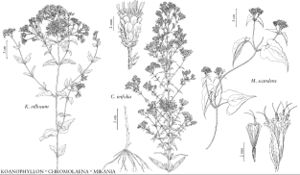Mikania scandens
Sp. Pl. 3: 1743. 1803.
Stems obscurely 6-angled to terete, glabrate to densely pilose; internodes 8–15 cm. Petioles 20–50 mm, glabrous or puberulent. Leaf-blades triangular to triangular-ovate, 3–15 × 2–11 cm, bases cordate to hastate, margins subentire to undulate, crenate, or dentate, apices acuminate (tips often caudate), faces puberulent. Arrays of heads dense, corymbiform, 12–15 × 12 cm. Heads 6–7 mm. Phyllaries green or pinkish to purplish, linear to lanceolate, 5–6 mm, apices acuminate (faces glabrous or puberulent). Corollas usually pinkish to purplish, sometimes white, 3–5.4 mm, sparsely glanddotted, lobes triangular to deltate. Cypselae dark-brown to blackish, 1.8–2.2 mm, densely glanddotted; pappi of 30–37 white or pinkish to purplish bristles 4–4.5 mm. 2n = 38.
Phenology: Flowering Jun–Dec.
Habitat: Wet, open areas along streams, seeps, springs, margins of lakes, swamps
Elevation: 0–500 m
Distribution

Ala., Ark., Conn., Del., D.C., Fla., Ga., Ill., Ind., Ky., La., Maine, Md., Mass., Mich., Miss., Mo., N.H., N.J., N.Y., N.C., Okla., Pa., R.I., S.C., Tenn., Tex., Va., Mexico, West Indies (Bahamas)
Discussion
The name Mikania scandens was once used to refer to most of the slender twiners with sagittate, hastate, or cordate leaf bases and corymbiform capitulescences in tropical and temperate America. As a result of work of B. L. Robinson (1934), the name is now used to refer to plants distributed primarily in eastern United States.
Mikania scandens was reported as occurring in Ontario, Canada (M. L. Fernald 1950; J. A. Steyermark 1963); it has been deleted from the flora of Canada (H. J. Scoggan 1978–1979, part 4). The Canadian reports were seemingly based upon misdeterminations and/or “too loose an application of that name with respect to present political boundaries.” Records of M. scandens from along the Ohio River, Hamilton County, Ohio, are apparently based on non-persistent introductions; the species is apparently extirpated from Indiana, Maine, and Michigan.
Selected References
None.
Lower Taxa
"fine" is not a number.
